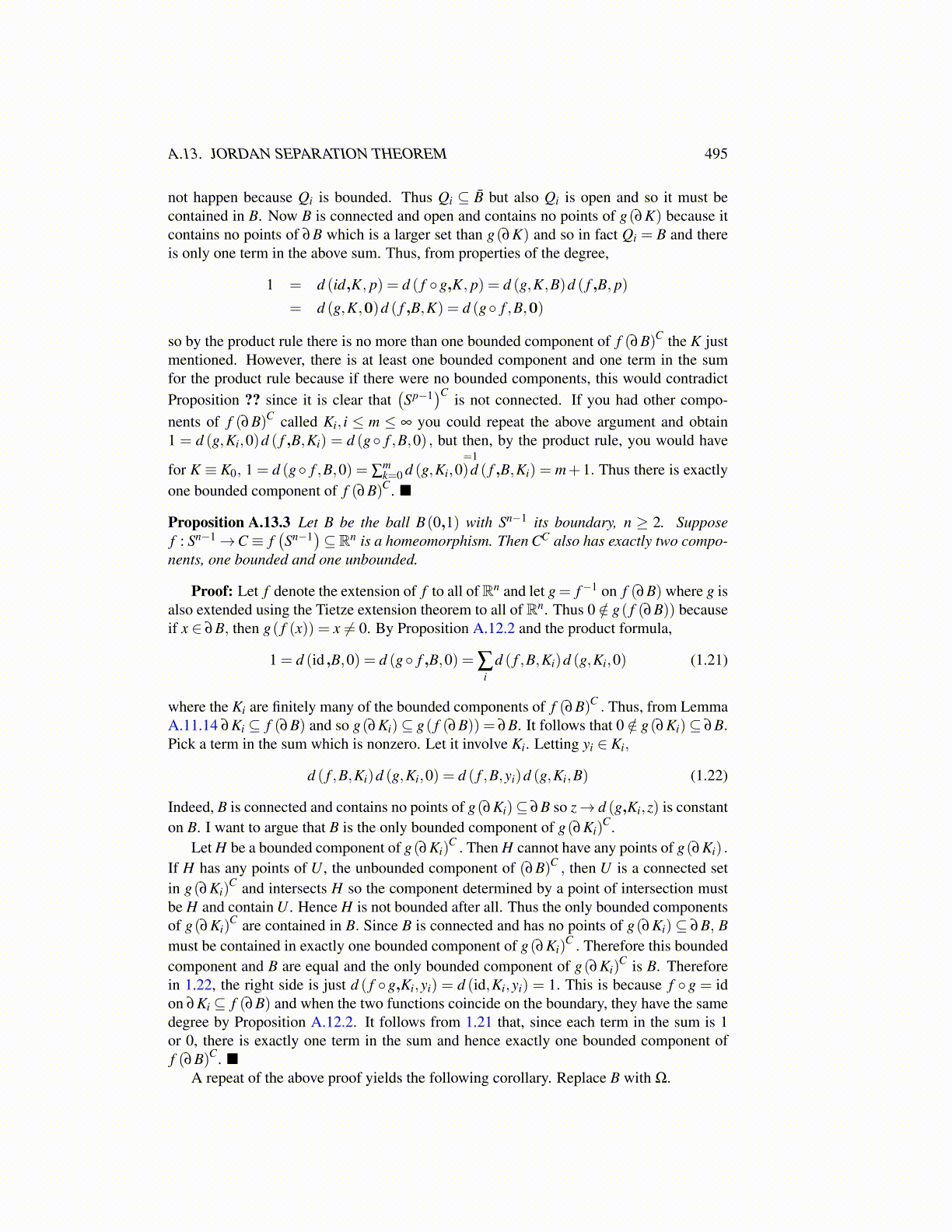
A.13. JORDAN SEPARATION THEOREM 495
not happen because Qi is bounded. Thus Qi ⊆ B̄ but also Qi is open and so it must becontained in B. Now B is connected and open and contains no points of g(∂K) because itcontains no points of ∂B which is a larger set than g(∂K) and so in fact Qi = B and thereis only one term in the above sum. Thus, from properties of the degree,
1 = d (id,K, p) = d ( f ◦g,K, p) = d (g,K,B)d ( f ,B, p)
= d (g,K,0)d ( f ,B,K) = d (g◦ f ,B,0)
so by the product rule there is no more than one bounded component of f (∂B)C the K justmentioned. However, there is at least one bounded component and one term in the sumfor the product rule because if there were no bounded components, this would contradictProposition ?? since it is clear that
(Sp−1
)C is not connected. If you had other compo-nents of f (∂B)C called Ki, i ≤ m ≤ ∞ you could repeat the above argument and obtain1 = d (g,Ki,0)d ( f ,B,Ki) = d (g◦ f ,B,0) , but then, by the product rule, you would have
for K ≡ K0, 1 = d (g◦ f ,B,0) = ∑mk=0
=1d (g,Ki,0)d ( f ,B,Ki) = m+1. Thus there is exactly
one bounded component of f (∂B)C. ■
Proposition A.13.3 Let B be the ball B(0,1) with Sn−1 its boundary, n ≥ 2. Supposef : Sn−1→C≡ f
(Sn−1
)⊆Rn is a homeomorphism. Then CC also has exactly two compo-
nents, one bounded and one unbounded.
Proof: Let f denote the extension of f to all ofRn and let g = f−1 on f (∂B) where g isalso extended using the Tietze extension theorem to all of Rn. Thus 0 /∈ g( f (∂B)) becauseif x ∈ ∂B, then g( f (x)) = x ̸= 0. By Proposition A.12.2 and the product formula,
1 = d (id ,B,0) = d (g◦ f ,B,0) = ∑i
d ( f ,B,Ki)d (g,Ki,0) (1.21)
where the Ki are finitely many of the bounded components of f (∂B)C . Thus, from LemmaA.11.14 ∂Ki ⊆ f (∂B) and so g(∂Ki)⊆ g( f (∂B)) = ∂B. It follows that 0 /∈ g(∂Ki)⊆ ∂B.Pick a term in the sum which is nonzero. Let it involve Ki. Letting yi ∈ Ki,
d ( f ,B,Ki)d (g,Ki,0) = d ( f ,B,yi)d (g,Ki,B) (1.22)
Indeed, B is connected and contains no points of g(∂Ki)⊆ ∂B so z→ d (g,Ki,z) is constanton B. I want to argue that B is the only bounded component of g(∂Ki)
C.Let H be a bounded component of g(∂Ki)
C . Then H cannot have any points of g(∂Ki) .
If H has any points of U , the unbounded component of (∂B)C , then U is a connected setin g(∂Ki)
C and intersects H so the component determined by a point of intersection mustbe H and contain U . Hence H is not bounded after all. Thus the only bounded componentsof g(∂Ki)
C are contained in B. Since B is connected and has no points of g(∂Ki)⊆ ∂B, Bmust be contained in exactly one bounded component of g(∂Ki)
C . Therefore this boundedcomponent and B are equal and the only bounded component of g(∂Ki)
C is B. Thereforein 1.22, the right side is just d ( f ◦g,Ki,yi) = d (id,Ki,yi) = 1. This is because f ◦ g = idon ∂Ki ⊆ f (∂B) and when the two functions coincide on the boundary, they have the samedegree by Proposition A.12.2. It follows from 1.21 that, since each term in the sum is 1or 0, there is exactly one term in the sum and hence exactly one bounded component off (∂B)C. ■
A repeat of the above proof yields the following corollary. Replace B with Ω.